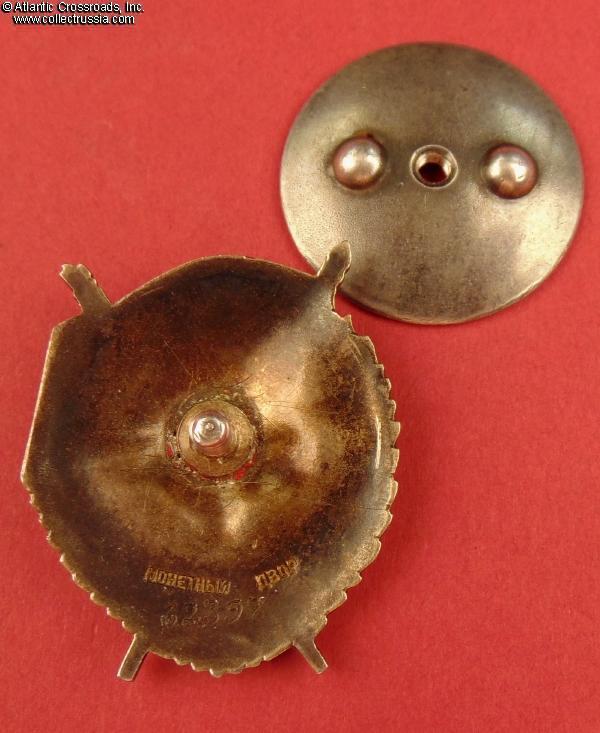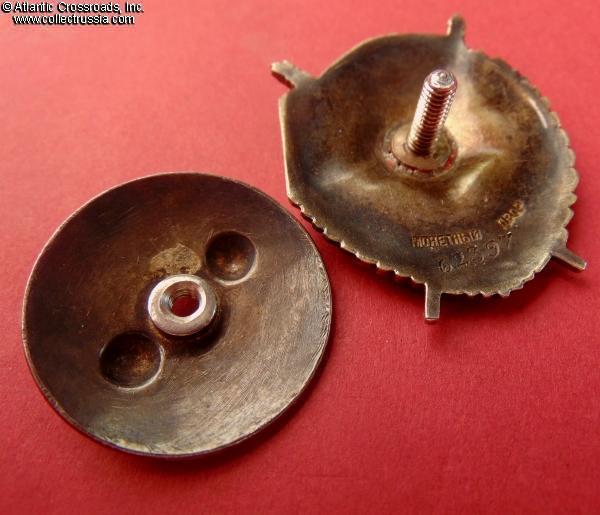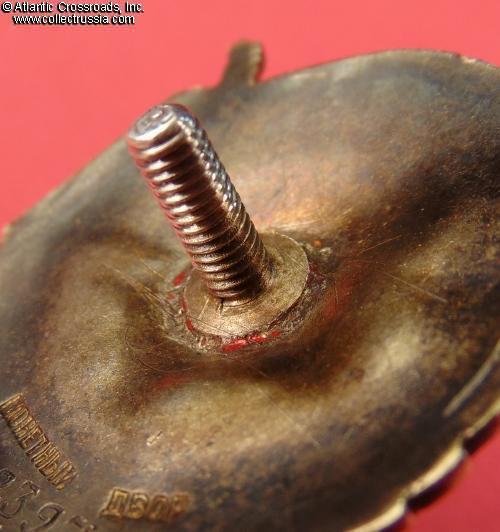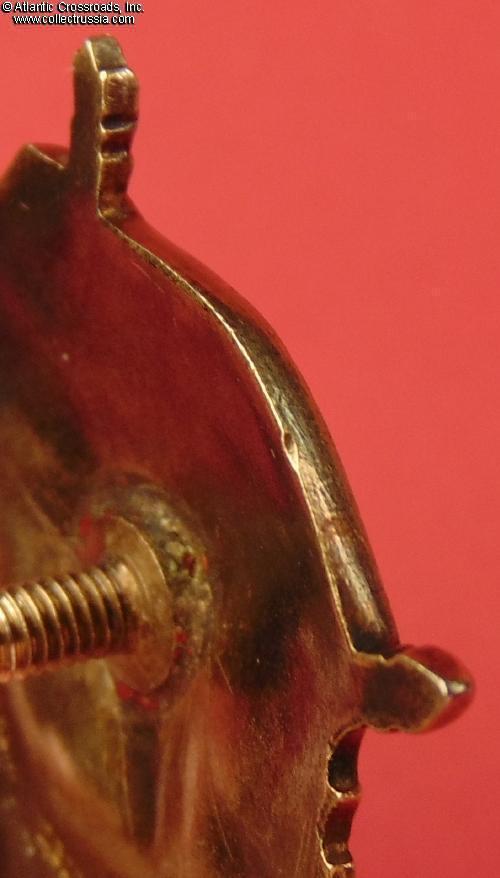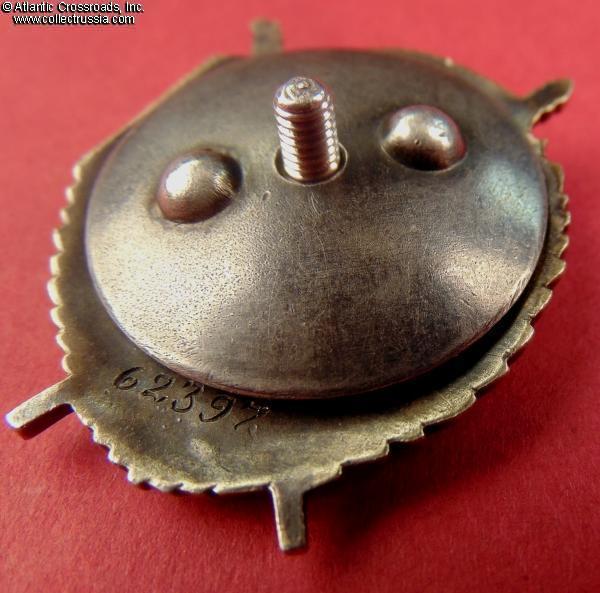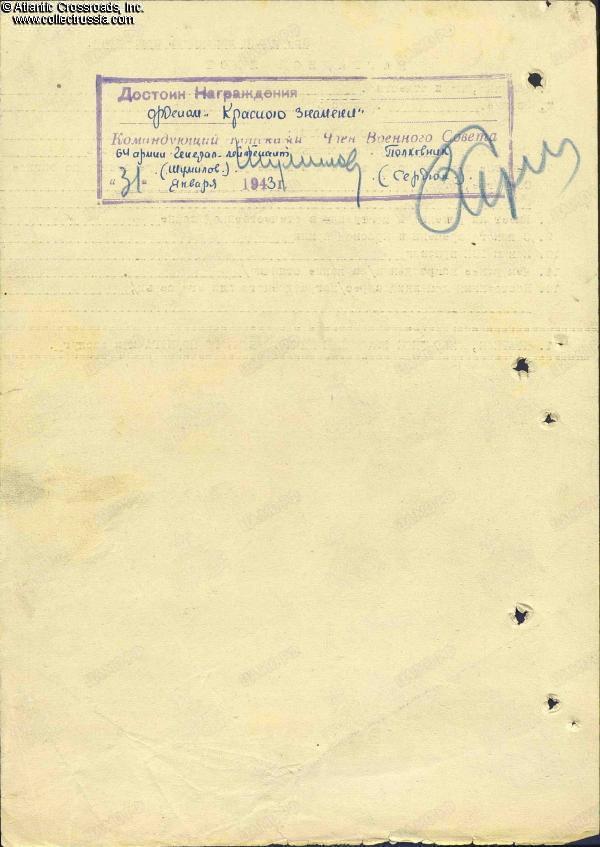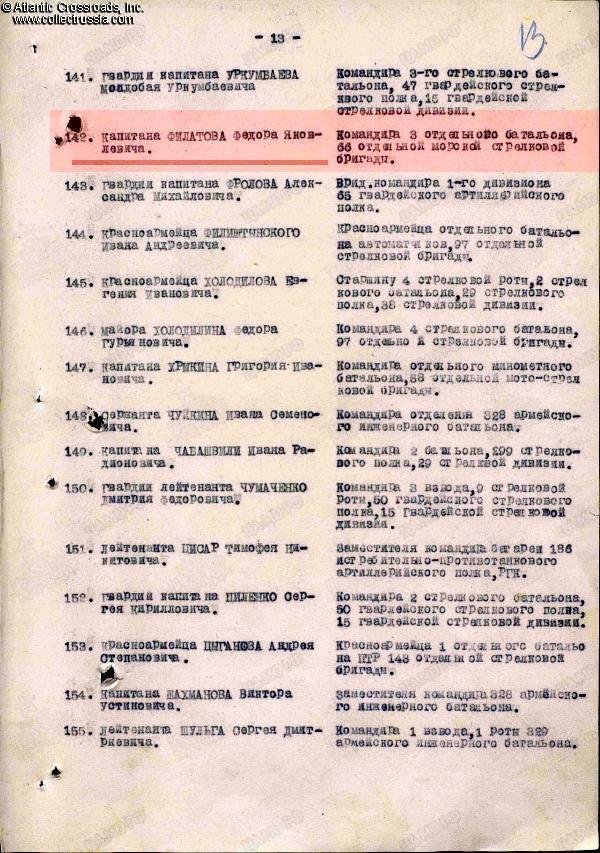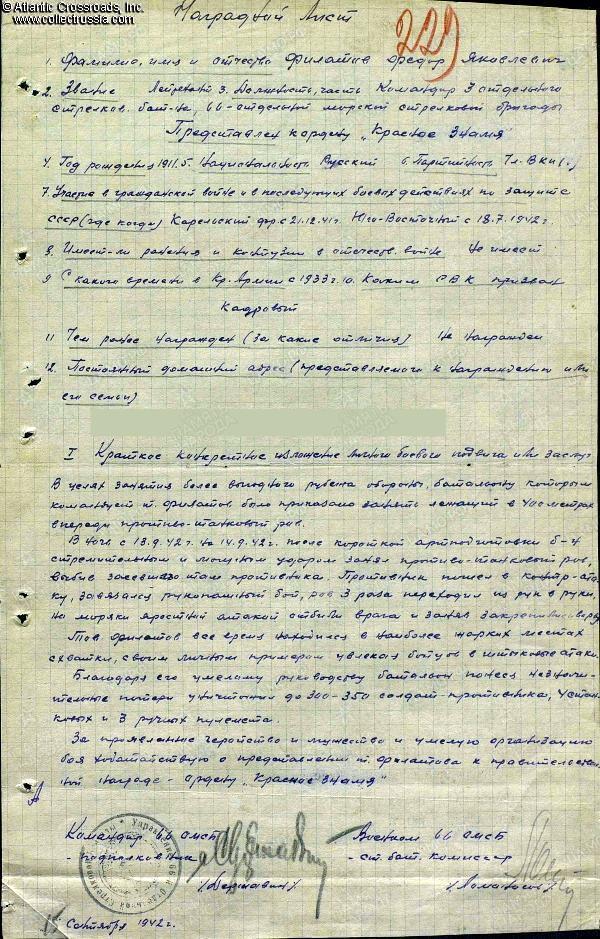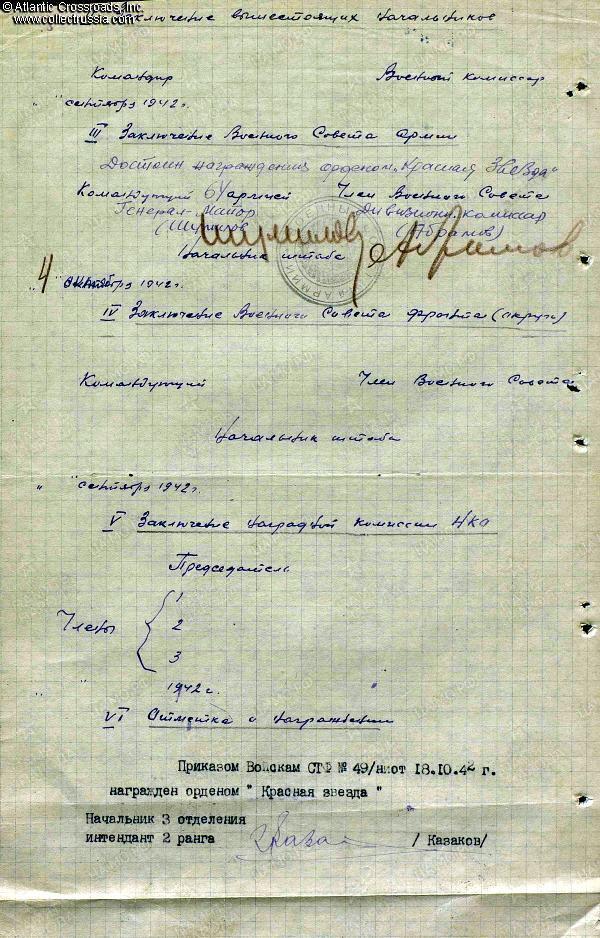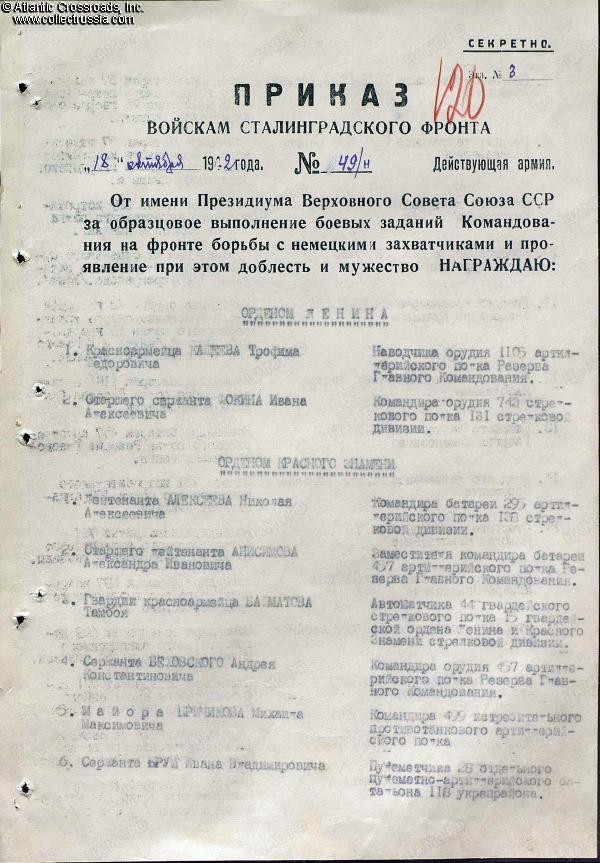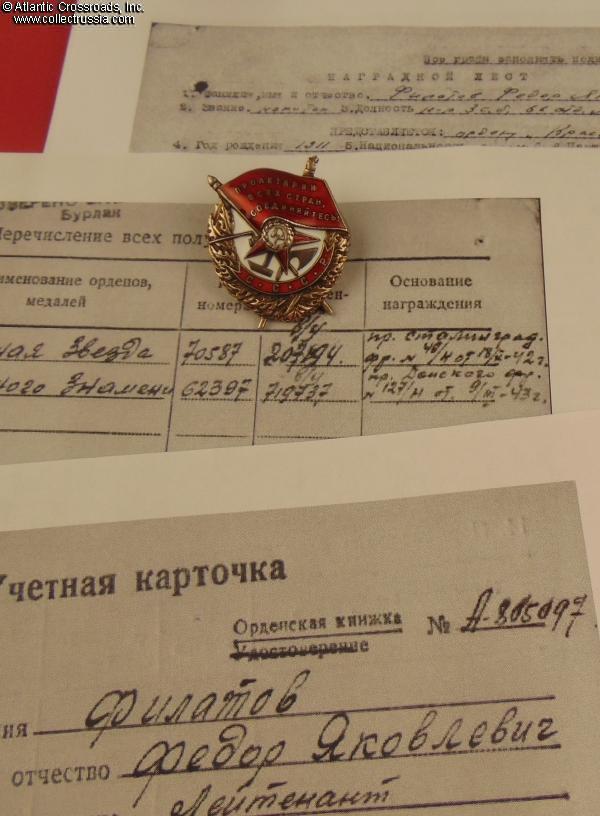Order of the Red Banner, Type 2, Variation 3, Sub-variation 1, #62397, awarded on 9 February 1943 to Captain Fyodor Filatov (Федор Яковлевич Филатов), a Battalion Commander with the 66th Separate Naval Rifle Brigade, 64th Army, Don Front, for the Battle of Stalingrad.
Silver gilt, enamels; measures 41.1 mm in height (from the top of the flag to the bottom of the wreath); 37.2 mm in width; weighs 23.2 g without the screw plate. According to the reference guide Order of the Red Banner by Durov and Strekalov, this piece was manufactured in 1942 at the Krasnokamsk Mint.
In very fine condition, far above the average for a Type 2 screw back version. Very uncharacteristically, the enamel on the banner is free of penetrating chips, rubbing or repairs, and appears almost perfect to the unaided eye. Visible under a 10x magnification, there are some shallow surface flakes in the most exposed area immediately above the star and along the edges near the lower right corner, but all of them are almost unnoticeable without magnification and have practically no effect on the overall appearance of the award. The enamel on the red scroll with "CCCP" as well as the lower and left arms of the star likewise has only some tiny surface flakes that are nearly invisible without magnification. The enamel is mostly missing on the left arm of the star (in an amateur fashion, it is repaired with a simple red lacquer or nail polish which probably can be easily removed with acetone.) The white enamel has a tiny amount of surface flaking in the center around the hammer & sickle emblem, otherwise perfect.
The details of the wreath, flagpole and torch are exceptionally well-preserved and crisp, showing almost no wear. A very good amount of the original fire gilt finish is present throughout. The reverse is essentially pristine and exhibits a beautiful dark patina to silver, while some of the characteristic "spillover" gilt along the edge is clearly visible along its perimeter. The order has not been converted to suspension and retains its original, full-length screw post measuring over 11.5 mm long from its base. Original silver screw plate is included. Overall, a magnificent unaltered piece. To reiterate, its condition is unusually nice for the early "Screw Back" type Red Banner.
Fyodor Filatov was born in 1911 in a village of the Penza province of the Russian Empire. Having only an elementary school education, he enlisted in the Red Army in 1933 and eventually became a career military officer. During the Patriotic War, he was on the front lines starting from December 1942, initially with the Karelian Front and from July 1942, with the Southeastern / Stalingrad Front.
As of September 1942, Filatov had the rank of lieutenant, serving as a battalion commander with the 66th Separate Naval Rifle Brigade. This unit was created in the Volga Military District in October - November 1941 using the available cadre from the Pacific Fleet and Amur Flotilla - one of many such "trump cards" transferred west from the Soviet Far East once it had become clear that Japan had no immediate plans to attack the Soviet Union. In December 1941, the 66th Naval Brigade was assigned to the Karelian Front, but as the German Operation Blau began gathering steam in June - early July 1942, the brigade was hastily moved south, becoming a part of the newly formed 64th Army of the Stalingrad Front. It would remain with the 64th Army for the duration of the Battle of Stalingrad and through the end of the war.
Initially, the 64th Army was defending the Stalingrad outer perimeter along the Tsymla River and then along the Surovikino - Rychkovo line. It then made a heroic stand against the Hoth's Fourth Panzer Army which was pushing into Kuporosnoe (aka Kuporosnyi district) in the southern part of Stalingrad. By early September, most of the artillery of the 64th Army had been moved east across the Volga, while only the frontline infantry - including the 66th Naval Rifles - remained on the west bank to hold the bridgehead. On 10 September, the army launched a spirited counterattack that threw the Germans half a mile away from the Volga River. Nevertheless, within days it was completely pushed out of Stalingrad into the southern suburb of Beketovka as the Germans captured Kuporosnoe and gained a firm foothold on the Volga. Thus, they split the Soviet forces in Stalingrad in two disjoint parts: one to the north in a shallow bridgehead along the Volga, held by the 62nd Army led by its newly appointed - and soon to become legendary - commander Gen. Chuikov; and another one to the south in Beketovka, held by the 64th Army that had been previously commanded by Chuikov. For a good reason, September 10th was called "the darkest day for the defenders" by Earl Zemke in his outstanding book Moscow to Stalingrad: Decision in the East.
Albeit presently out of the city proper, the 64th Army would remain a thorn in the German side for the duration of the defensive phase of the battle, constantly attacking the southern flank and draining the ever-dwindling resources of the German Sixth Army and Fourth Panzer Army. On the night of 13-14 September, Lt. Filatov's naval battalion launched one such attack, aiming to capture an antitank ditch 400 meters ahead of the front line. Judging by the available maps of the battle, the engagement likely took place in close proximity to the Stalingrad Grain Elevators. Led by Filatov, the naval riflemen kicked the enemy out of the ditch and in fierce close combat repelled a counterattack, securing the advantageous new position. The battalion eliminated up to 300-350 German troops and captured seven machine guns, including four heavy and three light. Throughout the skirmish, the Filatov was constantly in the thick of fighting, appearing in the most contested locations and encouraging his men by personal example. On 15 September, he was recommended for the Order of the Red Banner by the brigade commander for both exceptional heroism and skillful leadership. The recommended decoration was however downgraded to the Order of the Red Star by the Commander of the 64th Army Maj. Gen. Shumilov and his chief political officer Divisional Commissar Abramov. This award - a very uncommon one at that early and difficult stage of the battle - was officially bestowed upon Filatov on 18 September 1942 by a general order of the Stalingrad Front.
Filatov earned his second decoration of the war during Operation Koltso ("Ring"), the last stage of the Battle of Stalingrad. On 10 January, the Soviet fronts keeping the German pocket in a stranglehold were ready to strike the final blow against the now exhausted, starving and all but abandoned Sixth and Fourth Panzer Armies. At the start of the offensive, the 66th Naval Brigade along with one of the 64th Army's divisions and several rifle brigades was holding a defensive line in wide semicircle extending from the village of Elkhi to Kuporosnoe and thus hemming the Stalingrad cauldron from the southeast. The 66th Brigade's specific position at that point was on the army's extreme east at Elkhi, facing the German 279th Infantry Division. In the first days of the Operation Ring, the advance of 64th Army looked less dramatic than the rapid Soviet gains in the eastern and northern sectors of the battle, but it nevertheless made steady progress, crossing the Chervlyonaya River and compressing the pocket northward toward the center of the city. The German line near Elkhi however was pushed back only a few kilometers retreating northeast toward Starodubovka but not yet breaking. The final collapse there happened only during the second stage of the Operation Ring which commenced on January 21st, just as the Germans inside the pocket lost their last remaining operational airfield in Gumrak.
Lt. Filatov, then already with the rank of Captain, acquitted himself exceptionally well in all the active operations of his brigade from 15 - 24 January. Within this period, the 64th Army and its 66th Naval Brigade fought its way through the settlement of Peschanka, captured Alekseevka and Voroponovo railways stations, and reached the Verknyaya Yelshanka area of Stalingrad. On 15 January, Filatov was wounded in combat, but that did not prevent him from leading his battalion for the following ten days. According to the subsequent award recommendation, he showed outstanding bravery under fire and utter contempt of death, often engaging numerically superior enemy forces and inspiring his troops by personal example. On 26 January - full week before the final German surrender in Stalingrad - Filatov was once again recommended for the Order of the Red Banner by his brigade commander. On this occasion, the recommendation was almost immediately approved by the 64th Army Commander Lt. Gen. Shumilov and his chief political officer, who both signed the final order on 31 January. It would take however until 9 February 1943 for the army to officially bestow the award.
On 27th January, the Soviet Stavka (High Command) made a decision to transfer several units of the Don and Stalingrad Fronts into its reserves, including the 66th Naval Rifle Brigade. The aim was apparently to preserve the fighting strength of some of the best troops for the offensives that the Stavka was already planning for 1943, notably in the Donbass and Kursk regions. The 66th Naval Brigade in particular had fought so heroically that in March 1943 it was promoted to a Guards unit, becoming the 11th Guards Naval Rifle Brigade. For its role in the Battle of Stalingrad. the brigade was also awarded with the Order of the Red Banner It is also worth mentioning that it was none other than the 64th Army that accepted the surrender of Field Marshal Friedrich Paulus on 31 January 1943 (the fighting in Stalingrad would continue for another two days).
It is not clear if Filatov remained on active duty in the military through the end of the war, but the two orders earned in Stalingrad remained his only decorations of WW2. Interestingly, although he had the rank of captain at the time of being awarded with the Red Banner, he was once again a lieutenant at his retirement from the military, same as at the start of the Battle of Stalingrad. We can only assume that he was demoted for some unknown transgression, an event that possibly ended his military career. That however did not prevent Filatov from becoming an official in the Communist Party Committee of Telegino District of his native Penza Region, the position he held as of November 1946.
Research Materials: Photocopy of the award record card and award commendations for the Order of the Red Star and Order of the Red Banner. Information about the 66th Naval Rifle Brigade can be found online and in Vol. VII Red Death of Charles Sharp's book series on Soviet order of battle in WW2. For an account of the 66th Naval Brigade's actions in the Battle of Stalingrad, see Vol. 2 Armageddon in Stalingrad and Vol. 3 Endgame at Stalingrad of David Glantz's excellent Stalingrad trilogy.
Item# 43820
$3,800.00 Add to cart




